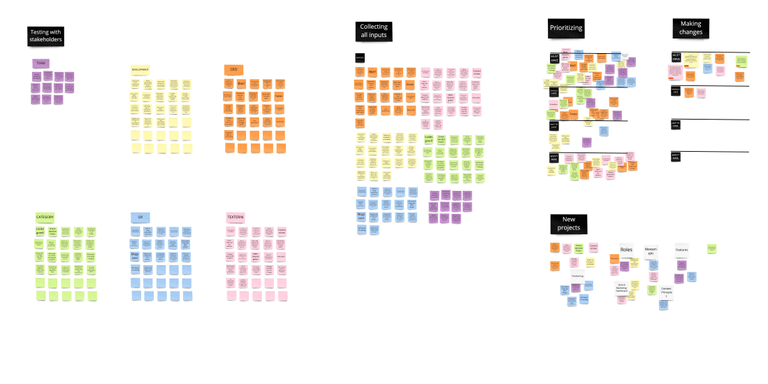Content Strategies are not typically tested with users
And we didn’t plan to do so in the beginning. The project started relatively conventional. My colleague Caroline Pieracci was asked to do the Content Strategy for a Swiss retailer and invited me to join the team. As a UX Designer I was asked to lead the stakeholder interviews for the client.
The first workshop was dedicated to get insights about the strategy of the client, their business goals and customer needs. To understand how we can help reach these goals with content, we are proposing a core message. Of course the main topics the client wants to talk about and what users are interested in was part of that too.
But why stakeholder interviews?
I mostly do stakeholder interviews at the very beginning of the project, to understand their goals, needs and pain points. It seemed a bit late in the process for me. When asked this question, the client explained that they wanted to inform the stakeholders, get their feedback, understand if the content strategy was valuable for them and get their buy in. During the reflection with Caroline about everything we heard from the client, I felt that what they actually wanted was to communicate and to test their Content Strategy.
A prototype to communicate important aspects of your project
Prototypes serve various purposes. Either to explore different solutions and opportunities, or to evaluate a solution, reduce the number of options and decide what to focus on. Or to communicate important aspects of your project. A communicative prototype can ignite meaningful discussions with your stakeholders and reduce friction and misunderstandings right from the start. It can be a valuable strategic tool to present, convince and inspire your management or stakeholders. That is why our client was all in and the prototyping began.
We used a PowerPoint presentation as a prototype #nokidding
Caroline had a poster in mind as the final delivery. A nicely designed visualisation of the core messages for the team to hang up in their office. In the end, our prototype was a PowerPoint presentation as this is the main medium for communication used by our stakeholders. It explained each part of the strategy and how it was created. The presentation was not polished at all, neither designed, and it had some blanks and question marks in it. We even put a “draft” sticker on each slide to make sure that the presentation was not judged by its bad looks.
Five interviews in one day
The testing was done remotely, all in one day and with the whole project team present. From the stakeholder map that we prepared in the kick-off meeting, our client picked the five most important people they wanted to talk to. We had 10 min to present the prototype and 20 min to ask our questions.
- After seeing our content strategy prototype, what questions do you have? What is unclear for you?
- What is your first impression of the content strategy, what goes through your mind?
- What is still missing in our content strategy?
- What is superfluous?
- What opportunities do you see when we implement this content strategy?
- What risks do you see?
- What does it take to make this content strategy a success?
- Is there anything else you would like to say on the subject?
The whole project team took notes. After each interview all the details were collected on our Miroboard. This took about 20-25 min and after a short break the next interview took place. The technique and the questions are coming from Jake Knapps book Sprint and felt great to be used in the context.Confidence to release the Content Strategy
The feedback was very positive and gave the client a great boost and a lot of confidence to be on track. The stakeholders were pleased to see the Content Strategy in an early stage. Their feedback also pointed out a couple of things that were missing or not clear enough.
The next day we met again and put all the feedback from the interviews on a huge “pile” on the Miroboard and prioritized them to decide what we will implement for the first release of the Content Strategy. We used the MoSCoW method and organised them into “must have’s”,”should have’s” and “won't have’s”.Continuous adaptation
The team that would mainly work with the Content Strategy on a daily basis, was invited to give their feedback on the prototype too. We are planning to invite them again, after they have worked with the Content Strategy for a while, to understand what works well for them and what doesn’t. It is a living document that needs to be adjusted and improved regularly.
Reduce risk and uncertainty
Experimentation, prototyping and testing is not always easy, but this project went down really smooth, and the collaboration with the client was great. The only challenge was to keep the prototype basic enough and to avoid putting too much effort in it or try to making it perfect. Something we’re not used to in our industry, where every typo is a sign of incompetence and a bad image can damage our customers' trust in us. The whole process was done in a few weeks and without a huge budget.
But what was the value for the client in the end? I find these words from Service Design Doing sums it up perfectly: “Prototyping is an essential activity to reduce risk and uncertainty as early and as cheaply as possible, to improve the quality of your final deliverable and eventually implement your project successfully”

